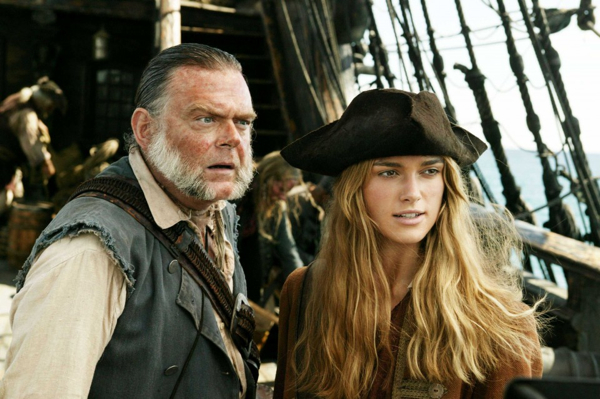Movie review by Greg Carlson
The snazzy sequel to “Pirates of the Caribbean: The Curse of the Black Pearl” glides into port bigger, louder, and (slightly) longer than the original, which will please as many viewers as it annoys. Loosely based on the beloved Disneyland theme park attraction, the “Pirates of the Caribbean” franchise has turned into a juggernaut for producer Jerry Bruckheimer and director Gore Verbinski. Owing more to magnetic star Johnny Depp than any other single element, the second part of the trilogy, subtitled “Dead Man’s Chest,” tries to blend the charming presence of its leading man with bombastic computer generated effects – not always with brilliant results.
As pirate movies go, there’s nothing “Dead Man’s Chest” seems to fear. From the fabled Kraken to Davy Jones to the corporate evils of the East India Trading Company, the movie is just getting warmed up. There’s also the Flying Dutchman, enchantments and curses, a voodoo priestess, a tribe of hungry cannibals, and plenty of swordfights and swashbuckling for good measure. The film’s plot exists merely as a pretext to observe Depp in his element, cranking up the swishy persona of the colorful Captain Jack Sparrow.
Keira Knightley and Orlando Bloom, reprising their roles as ill-fated lovers, are merely along for the ride, but both performers have the opportunity to shine in a handful of entertaining gags. The movie is too busy, however, to allow our protagonists even a moment in which to share any meaningful personal affection. In the “Pirates” universe the supporting players are often the most outlandish, and “Dead Man’s Chest” delights in its gruesome gallery of beasties and baddies. Bill Nighy, virtually invisible under a squirming CG beard of tentacles, makes an impression as Davy Jones, proving every bit as dangerous as Sparrow’s first nemesis, Captain Barbossa. Naomie Harris is ideally cast as Tia Dalma, the bewitching voodoo sorceress.
Visually splendid, “Dead Man’s Chest” is a feast of costume and set design. Highlights include Jones at his magnificent pipe organ (which he plays with his facial appendages, naturally), Sparrow on the run as a personified melon kebab, and a spirited duel atop a giant Keaton-esque rolling wheel. While these treats are all welcome sights, the movie makes the critical error of subscribing to the more-is-more philosophy of summertime blockbuster filmmaking. Without question, the viewer would be better served – and probably just as happy – with a version significantly shorter than the two and a half hour marathon being presented.
“Dead Man’s Chest” also suffers a bit from “Part 2” syndrome, in that its function as the middle section of a three part saga forces it to leave several messes to be cleaned up in the final installment. It is probably too much to hope that the final chapter of “Pirates of the Caribbean” will focus on the kind of human interaction that stirs emotions as opposed to the skull-crushing action set pieces that dominate the threadbare plotting. If the franchise has a fatal flaw other than the bloated running times, it is certainly the mistaken notion that viewers do not appreciate depth and dimension alongside the explosions.
